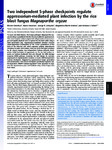Two independent S-phase checkpoints regulate appressorium-mediated plant infection by the rice blast fungus Magnaporthe oryzae
| dc.contributor.author | Osés-Ruiz, M | |
| dc.contributor.author | Sakulkoo, W | |
| dc.contributor.author | Littlejohn, George | |
| dc.contributor.author | Martin-Urdiroz, M | |
| dc.contributor.author | Talbot, NJ | |
| dc.date.accessioned | 2017-05-24T18:58:51Z | |
| dc.date.available | 2017-05-24T18:58:51Z | |
| dc.date.issued | 2017-01-10 | |
| dc.identifier.issn | 0027-8424 | |
| dc.identifier.issn | 1091-6490 | |
| dc.identifier.uri | http://hdl.handle.net/10026.1/9335 | |
| dc.description.abstract |
<jats:title>Significance</jats:title> <jats:p>Rice blast is a devastating fungal disease of cultivated rice, and its control is vital to ensure global food security. In an effort to understand how the rice blast fungus causes disease, we have investigated how the cell cycle controls the early stages of plant infection. The rice blast fungus develops a special cell, called an appressorium, to infect rice leaves. This structure generates enormous pressure, which the fungus applies as physical force to puncture the leaf surface. We have shown that a buildup of pressure in the appressorium is necessary to trigger an unusual cell-cycle checkpoint that is necessary for the appressorium to function properly. If this process is blocked, rice blast disease cannot occur.</jats:p> | |
| dc.format.extent | E237-E244 | |
| dc.format.medium | Print-Electronic | |
| dc.language | en | |
| dc.language.iso | en | |
| dc.publisher | Proceedings of the National Academy of Sciences | |
| dc.subject | fungi | |
| dc.subject | pathogen | |
| dc.subject | Pyricularia | |
| dc.subject | appressorium | |
| dc.subject | cell cycle | |
| dc.title | Two independent S-phase checkpoints regulate appressorium-mediated plant infection by the rice blast fungus Magnaporthe oryzae | |
| dc.type | journal-article | |
| dc.type | Journal Article | |
| dc.type | Research Support, Non-U.S. Gov't | |
| plymouth.author-url | https://www.webofscience.com/api/gateway?GWVersion=2&SrcApp=PARTNER_APP&SrcAuth=LinksAMR&KeyUT=WOS:000391439300016&DestLinkType=FullRecord&DestApp=ALL_WOS&UsrCustomerID=11bb513d99f797142bcfeffcc58ea008 | |
| plymouth.issue | 2 | |
| plymouth.volume | 114 | |
| plymouth.publication-status | Published | |
| plymouth.journal | Proceedings of the National Academy of Sciences | |
| dc.identifier.doi | 10.1073/pnas.1611307114 | |
| plymouth.organisational-group | /Plymouth | |
| plymouth.organisational-group | /Plymouth/Faculty of Science and Engineering | |
| plymouth.organisational-group | /Plymouth/Faculty of Science and Engineering/School of Biological and Marine Sciences | |
| plymouth.organisational-group | /Plymouth/REF 2021 Researchers by UoA | |
| plymouth.organisational-group | /Plymouth/REF 2021 Researchers by UoA/UoA06 Agriculture, Veterinary and Food Science | |
| plymouth.organisational-group | /Plymouth/Users by role | |
| plymouth.organisational-group | /Plymouth/Users by role/Academics | |
| dc.publisher.place | United States | |
| dcterms.dateAccepted | 2016-11-30 | |
| dc.identifier.eissn | 1091-6490 | |
| dc.rights.embargoperiod | No embargo | |
| rioxxterms.versionofrecord | 10.1073/pnas.1611307114 | |
| rioxxterms.licenseref.uri | http://www.rioxx.net/licenses/all-rights-reserved | |
| rioxxterms.licenseref.startdate | 2017-01-10 | |
| rioxxterms.type | Journal Article/Review | |
| plymouth.oa-location | http://www.pnas.org/content/114/2/E237.abstract |


